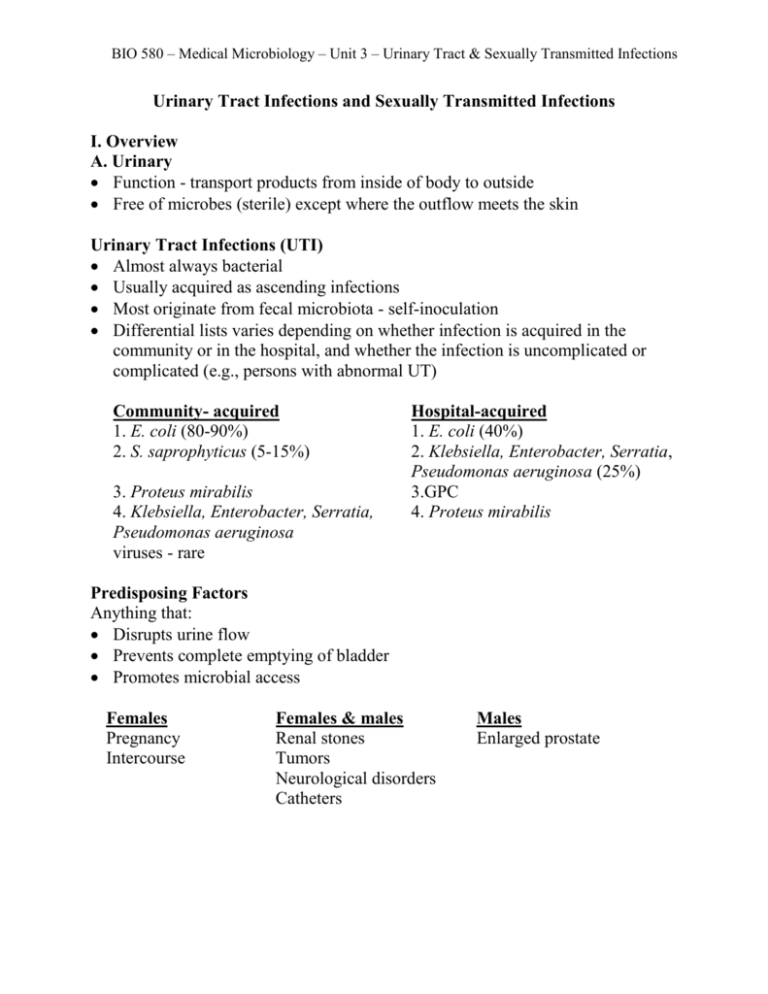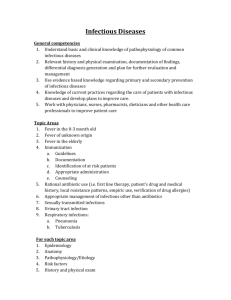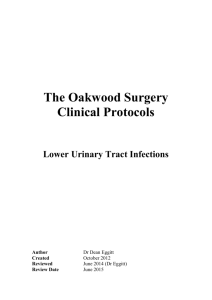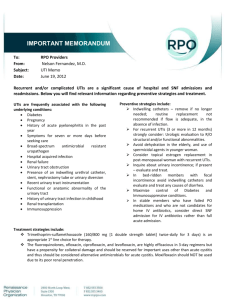BIO 580 - Medical Microbiology - Unit 3
advertisement

BIO 580 – Medical Microbiology – Unit 3 – Urinary Tract & Sexually Transmitted Infections Urinary Tract Infections and Sexually Transmitted Infections I. Overview A. Urinary Function - transport products from inside of body to outside Free of microbes (sterile) except where the outflow meets the skin Urinary Tract Infections (UTI) Almost always bacterial Usually acquired as ascending infections Most originate from fecal microbiota - self-inoculation Differential lists varies depending on whether infection is acquired in the community or in the hospital, and whether the infection is uncomplicated or complicated (e.g., persons with abnormal UT) Community- acquired 1. E. coli (80-90%) 2. S. saprophyticus (5-15%) 3. Proteus mirabilis 4. Klebsiella, Enterobacter, Serratia, Pseudomonas aeruginosa viruses - rare Hospital-acquired 1. E. coli (40%) 2. Klebsiella, Enterobacter, Serratia, Pseudomonas aeruginosa (25%) 3.GPC 4. Proteus mirabilis Predisposing Factors Anything that: Disrupts urine flow Prevents complete emptying of bladder Promotes microbial access Females Pregnancy Intercourse Females & males Renal stones Tumors Neurological disorders Catheters Males Enlarged prostate BIO 580 – Medical Microbiology – Unit 3 – Urinary Tract & Sexually Transmitted Infections Virulence Factors of Urinary Pathogens (examples): E. coli – uropathogenic strains (O and K serotypes) = UPEC pathogenicity island P fimbriae (attachment) capsular acid polysaccharide (resist phagocytosis) membrane active cytotoxins S. saprophyticus adherence to uroepithelium (high proportion of bladder cells w/ adherent bacteria) microbistatic to GP and GN urease P. mirabilis flagella (motility) urease Clinical Syndromes Lower UTI 1. urethritis (urethra) Symptoms - dysuria 2. cystitis (bladder) Symptoms - rapid onset of dysuria; increased urgency/frequency Urine - cloudy - pyuria (inflammation) or bacteriuria (bacteria); blood (hematuria) 3. prostatitis (prostate) Symptoms - dysuria, increased frequency, low back pain, systemic indications (fever) Upper UIT 1. pyelonephritis (renal parenchyma) Symptoms - cystitis + more severe systemic indications (fever) Complications - septicemia, loss of renal function Collecting Urine Samples Voiding (Midstream clean-catch) Urinary catheter Suprapubic bladder aspiration Laboratory Diagnosis of Urinary Tract Infections Read in text pages 257-259 carefully, especially pay attention to how to tell what is significant bacteriuria BIO 580 – Medical Microbiology – Unit 3 – Urinary Tract & Sexually Transmitted Infections B. Genital/Reproductive Only system that is significantly different in males & females Largely free of microbes, except for the vagina Sexually Transmitted Infection (STI) ( = Sexually Transmitted Disease (STD) = venereal disease (VD) Incidence is increasing Almost no vaccines Rampant on college campuses Often asymptomatic Sexually Transmitted Diseases - Top Ten in US By Occurrence Pathogen 1. Human Papillomavirus (HPV) 2. *Chlamydia trachomatis D-K. C. trachomatis L1, L2, L3 3. Candida albicans 4. Trichomonas vaginalis 5. Herpes simplex virus (HSV) 6. *Neisseria gonorrhoea 7. HIV 8. *Treponema pallidum 9. *Hepatitis B virus 10. Haemophilus ducreyi Disease genital warts; associated w/ cervical cancer non-specific or non-gonococcal urethritis lymphogranuloma venereum vaginal thrush, balanitis vaginitis, urethritis genital herpes gonnorhea AIDS syphilis hepatitis chancroid #1 Human Papilloma Virus (HPV) Transmission – sexually Entry – attach to target cell via capsid protein, enter via RME Incubation – 1-6 months Pathology – dyplasia = abnormal growth Symptoms – warts on penis, vulva, perianal regions (types 6 or 11) – BUT majority asymptomatic Complications – high-risk HPV types 16, 18, 31, 33, and 35 are strongly associated with cervical neoplasia Treatment (Txt) – asymptomatic and subclinical not treated; warts treated Prevention - vaccine BIO 580 – Medical Microbiology – Unit 3 – Urinary Tract & Sexually Transmitted Infections #2. Non-gonococcal urethritis - Chlamydia trachomatis - Obligate intracellular bacterium – Most common reported STI – 1,100,230 reported cases in U.S in 2009, 44,873 cases in Michigan. Transmission – sexual Entry – abrasions Attachment - to receptors on host cell, parasite-induced endocytosis Incubation – 2-6 weeks or longer Pathology – cells destruction & inflammation Symptoms – asymptomatic infection is common, esp. in women OR urethritis Complications –systemic dissemination, infertility – in women also PID, ectopic pregnancy – in infants pneumonia, trachoma. Treatment (Txt) – tetracycline, doxycycline, azithromycin #3. Yeast infection or Candida vulvovaginitis - Candida albicans – yeast, part of normal microbiota Transmission – normal microbiota of female vagina - disruptions to bacterial vagina community can result in an overgrowth with yeast. Symptoms – UTI, intensely itchy/burning, cottage cheesy discharge Balanitis (inflammation of glans penis) in 10% of male partners Txt – antifungals like micronazole or nystatin (topical) or oral fluconazole #4. Vaginitis - Trichomonas vaginalis - protozoa Transmission – sexual Entry – vagina in women; urethra and prostate in men Symptoms – vaginitis – copious, yellow/green frothy discharge, rise in vaginal pH Txt - metranidazole BIO 580 – Medical Microbiology – Unit 3 – Urinary Tract & Sexually Transmitted Infections #5. Genital herpes - Herpes simplex viruses types 1 and 2 (HSV1, HSV2) Transmission – sexual Entry - by membrane fusion Incubation – 3-7 days Pathology The herpes virus causes the membranes of host cells to fuse together to form “giant” cells. This picture was taken of PAP smear material and the arrow indicates a giant cell. Symptoms - First sign – primary genital lesion vesicles ulcer w/tender, swollen nodes, fever, headache, malaise The herpes virus travels up sensory nerve endings to the root ganglion neurons where it remains in a latent stage for the life of the host. The herpes virus can not be eliminated by the immune system or by anti-viral drugs. Herpes infections can re-activate. Virus travels back down the nerve fibers and causes new lesions at the surface of the skin or mucosal membranes. Reactivations are common and are triggered by trauma, stress, and sun. I it is believed that herpes infected individuals may always be somewhat infectious. Complications (in addition to reactivation) – aspetic meningitis or encephalitis in adults. Neonatal disseminated herpes or encephalitis. Txt – acyclovir (Zovirax), famciclovir, valacyclovir (Valtrex) BIO 580 – Medical Microbiology – Unit 3 – Urinary Tract & Sexually Transmitted Infections #6. Gonorrhea - Neisseria gonorrhoea – 260,530 U.S. in 2009/ 14,471 cases MI Transmission – direct, usually sexual, person-person If the woman has gonorrhea there is a 20% chance during each sexual encounter that she will transmit to her male partner. If the man has gonorrhea, there is a 5090% chance he will transmit to his partner (female or male). Asymptomatically infected individuals, almost always women, form a major reservoir of infection. Entry – vaginal or mucosa of penis – or other mucous membranes (pharynx, conjunctiva) Attachment - via common pilus (which undergoes antigenic variation), Opa proteins. Invade non-ciliated epithelial cells Incubation – 2-7 days Pathology – see picture– what process causes the damage? BIO 580 – Medical Microbiology – Unit 3 – Urinary Tract & Sexually Transmitted Infections Symptoms - First sign in men – dysuria, purulent discharge (shown center and a Gram stain of shown right, see the GNC engulfed by the PMNs). First sign in woman – vaginal discharge if symptomatic, BUT 50% asymptomatic Complications – similar to Chlamydia – pelvic inflammatory disease (PID) and/or damage to the fallopian tubes resulting in infertility in 10-20%, disseminated infection (1-3%), opthalmia neonatorum (neonate blindness shown at right – this is what newborns get silver nitrate drops to prevent, mandated in MI). Txt – Cefixime, Ciprofloxacin PLUS treat for Chlamydia – very often people who have gonorrhea have Chlamydia and visa versa. #7. Acquired Immune Deficiency Syndrome (AIDS) - Human Immunodeficiency Virus (HIV) – globally, 2.7 million new infections in 2008 Transmission - Sexually transmitted (but not a disease of the reproductive tracts but of the immune cells, specifically CD4+ cells like macrophages and TH), also transmitted by blood. Incubation – 2 weeks to 3 months, sometimes 6 months. Read in text pages 275-283. BIO 580 – Medical Microbiology – Unit 3 – Urinary Tract & Sexually Transmitted Infections #8. Syphilis ((#3 bacterial STI in U.S.) - Treponema pallidum – 12,833 U.S. in 2009/ 231 cases MI Transmission – close physical contact; usually sexual, saliva, blood - 1/3 of those exposed to the syphilis spirochete will become infected. Entry – small abrasions Incubation – 10-90 days, 3 weeks is average Symptoms - First sign – chancre – develops after 2-4 weeks - apparently not painful! Primary – the bacteria multiply in regional lymph nodes and cause swelling. Secondary – after 3-6 weeks, the bacteria multiply and produce lesions in many sites. Symptoms include myalgia, headache, fever, and rash (in 75-100% of cases). 2/3 are cured at this point but 1/3 develop go into a latent phase that can last 330 years, which can then progress to tertiary. Tertiary – bacteria again multiply and spread. Host cell-mediated response causes progressive destruction of neuro-, cardio-, skin, and/or joints. Complications – congenital syphilis (intrauterine death, congenital abnormalities) Txt – arsenic (historical), penicillin (modern) or doxycycline for pen-sensitive patients. If you haven’t seen the movie “Miss Evers’ Boys” you could watch this for extra credit (I know some rental places carry it, in the “true stories” section). It is about the Tuskegee experiments on syphilis conducted by the U.S. government. Relate presentation of syphilis in the movie with info from Medical Microbiology.







